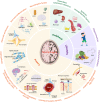Preserving cognitive function in patients with Alzheimer's disease: The Alzheimer's disease neuroprotection research initiative (ADNRI)
- PMID: 38223913
- PMCID: PMC10783281
- DOI: 10.1002/nep3.23
Preserving cognitive function in patients with Alzheimer's disease: The Alzheimer's disease neuroprotection research initiative (ADNRI)
Abstract
The global trend toward aging populations has resulted in an increase in the occurrence of Alzheimer's disease (AD) and associated socioeconomic burdens. Abnormal metabolism of amyloid-β (Aβ) has been proposed as a significant pathomechanism in AD, supported by results of recent clinical trials using anti-Aβ antibodies. Nonetheless, the cognitive benefits of the current treatments are limited. The etiology of AD is multifactorial, encompassing Aβ and tau accumulation, neuroinflammation, demyelination, vascular dysfunction, and comorbidities, which collectively lead to widespread neurodegeneration in the brain and cognitive impairment. Hence, solely removing Aβ from the brain may be insufficient to combat neurodegeneration and preserve cognition. To attain effective treatment for AD, it is necessary to (1) conduct extensive research on various mechanisms that cause neurodegeneration, including advances in neuroimaging techniques for earlier detection and a more precise characterization of molecular events at scales ranging from cellular to the full system level; (2) identify neuroprotective intervention targets against different neurodegeneration mechanisms; and (3) discover novel and optimal combinations of neuroprotective intervention strategies to maintain cognitive function in AD patients. The Alzheimer's Disease Neuroprotection Research Initiative's objective is to facilitate coordinated, multidisciplinary efforts to develop systemic neuroprotective strategies to combat AD. The aim is to achieve mitigation of the full spectrum of pathological processes underlying AD, with the goal of halting or even reversing cognitive decline.
Keywords: Alzheimer's disease; early intervention; neural regeneration; neuroprotection; systematic perspective.
© 2023 The Authors. Neuroprotection published by John Wiley & Sons Ltd on behalf of Chinese Medical Association.
Conflict of interest statement
Xunming Ji, Johannes Boltze, and Piotr Walczak are the Editors‐in‐Chief, and Heleen van Beusekom, Andrew N. Clarkson, Paulo Henrique Rosado de Castro, Tracy D. Farr, Jukka Jolkkonen, Shen Li, Yajie Liang, Guiyou Liu, Xiaobo Mao, Joaquim Miguel Oliveira, Mike M. Modo, Pedro Ramos‐Cabrer, Karsten Ruscher, Yun Wang, Haitao Wu, Lize Xiong, Yi Yang, Marietta Zille, and Yan‐Jiang Wang are the editorial members, of Neuroprotection. They are therefore excluded from the peer‐review process and all editorial decisions related to the publication of this manuscript. The remaining authors declare no conflict of interest.
Figures

References
-
- WHO . Dementia . 2022. Accessed May 20, 2023. https://www.who.int/news-room/fact-sheets/detail/dementia
-
- WHO . The Top 10 Causes of Death . 2020. Accessed May 20, 2023. https://www.who.int/news-room/fact-sheets/detail/the-top-10-causes-of-death
-
- World Alzheimer Report . 2022. Life after Diagnosis: Navigating Treatment, Care and Support. 2022. Accessed May 20, 2023.
Grants and funding
LinkOut - more resources
Full Text Sources
